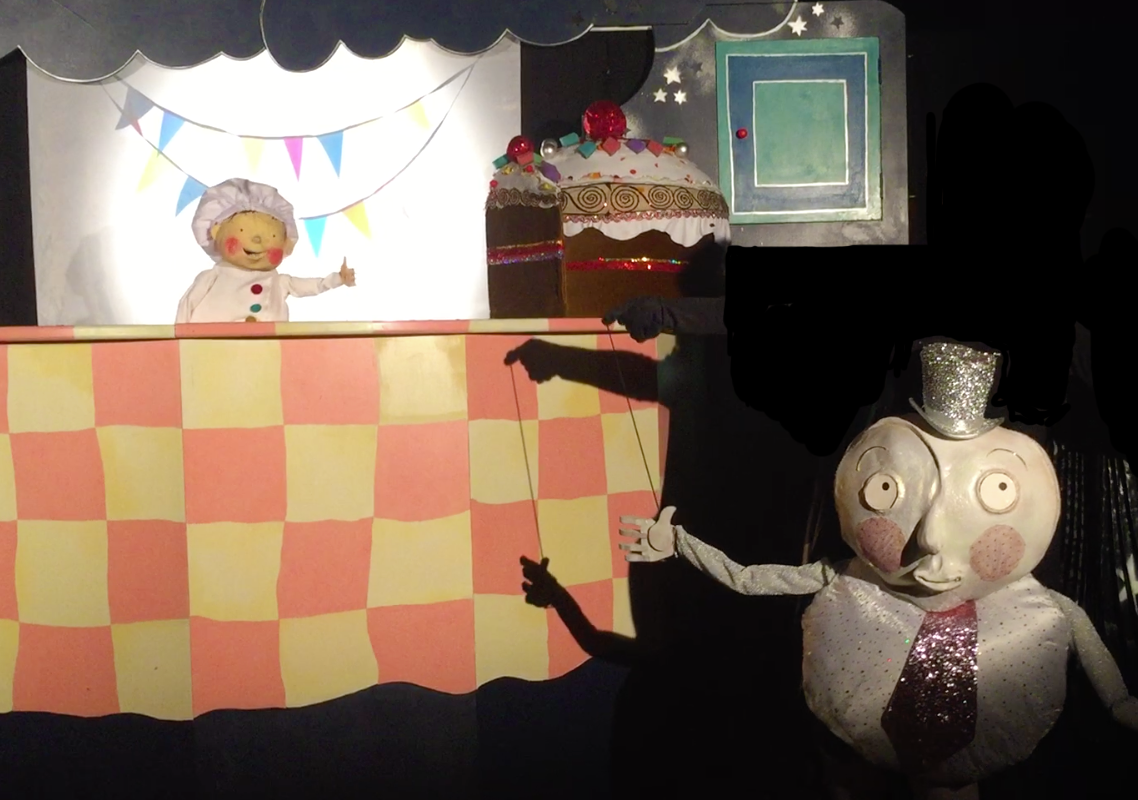The title feels familiar – there’s a song about that, right? – but in fact it’s a hybrid invention, a twist on the Pat-a-Cake nursery rhyme that features a host of familiar but reinvented characters from other ditties. This is very much the ethos of the production as a whole, whose ingredients are images and characters familiar from well-known rhymes and tales, here remixed and reimagined.
Our star is the cheeky and irrepressible Pat-a-Cake himself, a ruddy-cheeked baby glove puppet who first appears with a razzmatazz voice-over intro that wouldn’t feel out of place in the opening of a Saturday night reality TV show, appearing atop the Battenberg table-top set. He is aided and abetted in his task of waking up the Moon, whose mobile face and snores wittily open the show, by a trio of tiny baby gloves, all vibrantly pretty and full of mischief. For the Moon loves nothing more than cake, so here they are, in a darkened kitchen, about to cook up a storm. There is much for the young audience to identify with in this crew: in a smart move, Pat-a-Cake’s voice-over is provided by a very young child’s lisping voice (the others, Sooty-like, communicate only in mime and whispers to his ear) – they are playful, messy, learning on the job and of course, children themselves.
The cake-baking structure provides a strong architecture on which to hang cheerful and varied score with plenty of songs and a collection of witty puppetry sequences that bring each stage of the baking to life. Sugar? A sultry, sparkling lounge-singing sack; Eggs? A wonderfully bizarre shadow hen created with coloured shades and a very feathery boa. As you might expect in the work of a company led by artists whose background lies in illustration (Katherine Morton and Polly Dunbar), it is in its inventive puppetry choices that this show really flies: there’s plenty of object-driven visual wittiness and the making is first rate. Adapted from a book by Joyce Dunbar, (Polly’s mum), the story’s choices are smart and just on the right side of knowingness; many of the older children in the audience enjoyed the jokes. The show was aimed at 2–6 year-olds though, and I think making work that can appeal throughout to such a very wide constituency is a stretch. The production takes a fully illusionary approach, familiar for very young audiences from the approach of CBeebies type shows, with performers hidden behind the play-board set throughout allowing the weird and wonderful puppet creations to fully come to life. This, though, means a reliance on pre-recorded voice-over which, whilst keeping the action pacy and delivering an array of voices that could not have all been brought live to the stage, also undermines the show’s ability to play live with the audience. It’s confident, and brave to incorporate audience interaction into this prerecorded script, but of course invites the possibility that the audience responses don’t play as planned (as they didn’t at the show I attended), making the whole experience feel less immediate and live.
But who, though, doesn’t love cake? I had some questions about the form, and there were times when the younger and older members of the audiences were drifting in and out, but the pacy inventiveness in visuals, music and story meant they always came back. This is a tasty confection, and a lot of craft and care has gone into its creation. There’s a wonderful gag that brings the whole together at the end, and in this their fifth production Longnose continue to demonstrate their skilfulness in making surprising and highly visual puppetry work for young audiences. Sweet!

